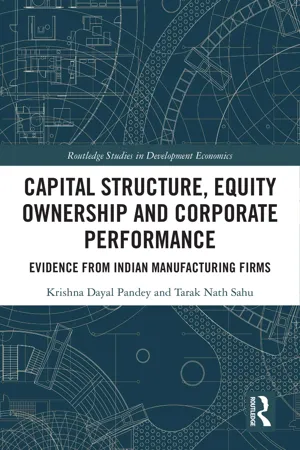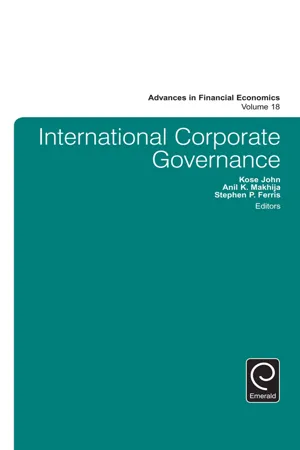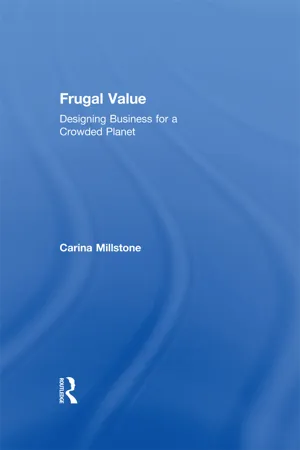Business
Ownership Structure
Ownership structure refers to the way a business is owned and organized, including the distribution of ownership among individuals or entities. It outlines the rights and responsibilities of owners, such as decision-making authority and profit distribution. Common ownership structures include sole proprietorships, partnerships, corporations, and limited liability companies, each with its own implications for liability, taxation, and governance.
Written by Perlego with AI-assistance
Related key terms
1 of 5
5 Key excerpts on "Ownership Structure"
- eBook - ePub
Capital Structure, Equity Ownership and Corporate Performance
Evidence from Indian Manufacturing Firms
- Krishna Dayal Pandey, Tarak Nath Sahu(Authors)
- 2023(Publication Date)
- Routledge(Publisher)
The conceptual and empirical frameworkDOI: 10.4324/9781003397878-3Ownership Structure: the conceptual aspects
Theoretically, the Ownership Structure of a business corporation refers to the pattern of distribution of its ownership to different kinds of investors. It reflects the types of equity holders and their proportion of equity holdings. Conceptually, there may be different kinds of participants in the ownership of a publicly held company. Broadly classifying the types, we get four kinds of investors, such as promoters, financial institutions, the public and governments. The promoters may be domestic or foreign affiliates. The institutional investors include banks and non-banking financial institutions, mutual fund companies, insurance companies and many more. The shares of companies also go to the hand of common citizens, which are categorized as public shareholdings. Similarly, a certain fraction of ownership may also be held by the central or the state government(s). Below we have given a detailed description of the two prominent shareholding types in the Indian corporate sector:Promoters’ shareholding
Promoters as a kind of shareholder in business corporations could not find good space in the Indian Companies Act, 1956. However, the term promoter was explained under section 62 of the Companies Act, 1956. Companies Act, 1956, merely considers a promoter as an individual who has been recognized as a party in the preparation of the prospectus of the company. The Securities and Exchange Board of India (SEBI) also provides a description of various types of promoters in Indian companies. SEBI (Issue of Capital and Disclosure Requirements) Regulations, 2009, sees promoters as any persons who are in control of the issuer, instrumental in the formulation of a plan and whose names are mentioned in the offer document as so. Besides, SEBI’s Substantial Acquisition of Shares and Takeover Regulations, 1997, and Disclosure and Investment Protection Guidelines, 2000, have given special status to promoters. According to SEBI, promoters are also supposed to play a crucial role by rigorously monitoring and regulating corporate affairs by virtue of their ownership and managerial rights. - eBook - PDF
- Daniel W. Halpin, Bolivar A. Senior, Gunnar Lucko(Authors)
- 2017(Publication Date)
- Wiley(Publisher)
1 Other desirable features of corporate structure that cause firms to select this legal structure will be discussed later in this chapter. Two types of corporations are commonly encountered. Corporations in which a small num- ber of persons hold all of the stock in the firm are referred to as close or closely held corporations. This form of ownership is common in the construction industry as it offers risk protection and also allows a small group of principals to control company policies and functions. A public cor- poration, in contrast to a closely held corporation, allows its stock to be bought and sold freely. The actual ownership of the stock varies daily as the stock is traded by brokers, in the case of large corporations, on the stock market. Another form of organization that has legal implications is the joint venture. This is not a form of ownership but a temporary grouping of existing firms defined for a given period to accomplish a given task or project. A joint-venture organizational structure is used when a large project is to be constructed and requires the pooling of resources or expertise from several com- panies. Typically, the companies establish a basis for division of responsibility on the job and cooperate toward the end of successfully completing the project. They are bound together for a period of cooperation by a legal agreement that defines the nature of the relationship. Joint ven- turing first became popular during the construction of large dams such as the Grand Coulee Dam and Hoover Dam in the western United States and has since been used for a wide variety of large construction tasks. 5.3 Proprietorship The simplest form of legal structure is the proprietorship. In this form of business ownership, an individual owns and operates the firm, retaining personal control. The proprietor makes all deci- sions regarding the affairs of the firm. - eBook - PDF
Corporate Governance
Theory and Practice
- Carol Padgett(Author)
- 2011(Publication Date)
- Bloomsbury Academic(Publisher)
OWNERSHIP LEARNING OBJECTIVES To understand the nature of shareholders’ rights To understand the difference between ownership and control of companies To appreciate different patterns of ownership around the world To see how different Ownership Structures can lead to different governance issues To comprehend why different groups of shareholders may have different aims for the company To appreciate the empirical literature on the effects of owner characteristics on corporate performance INTRODUCTION Businesses come in all shapes and sizes and several legal forms. An individual who operates as a sole trader can be thought of as the company because they are both the owner and the decision-maker. The situation is similar in a partnership , with the slight complication that the partners must either agree all decisions or deter-mine a division of labour in which each has responsibility over a particular area. In both cases the owners of the business are able to control it. The same cannot always be said in a limited liability company . Some small business owners choose to form companies so as to create a legal separation between themselves and the company and to take advantage of limited liability. In this case a single person might own all the shares and run the firm in exactly the same way they would run a sole tradership. The key difference is that if the company goes bankrupt the share-holder can only lose the value of the shares because he owns securities rather than the company itself. A sole trader or partner remains personally liable for all the company’s debts because they are not legally separate from it. When the company has several shareholders they can all enjoy limited liability, but their ownership is diluted and they cannot think of the firm as their own in the way a sole owner can. - eBook - PDF
- Kose John, Stephen P. Ferris, Anil K. Makhija, Kose John, Stephen P. Ferris, Anil K. Makhija(Authors)
- 2015(Publication Date)
- Emerald Group Publishing Limited(Publisher)
In this paper, we fill this gap in the literature by examining the influ-ence of Ownership Structure on a blockholder’s power. First, we provide a comprehensive description of Ownership Structures of American corpora-tions in terms of the number of blockholders as well as their ownership stakes. 3 Second, we show that, due to differences in Ownership Structures, blockholders with similar ownership stakes may have significantly different power in the firm. Finally, we show that the influence of ownership struc-ture on a blockholder’s power varies systematically with her rank and iden-tity. A secondary issue that we address pertains to the differences between the Ownership Structures of younger and smaller firms compared to older and more mature firms. Throughout our analysis, we focus separately on these two groups of firms and note the differences and similarities between their ownership and power structures. Consider the following three examples that highlight some of the varia-tion in the Ownership Structures of our sample firms. First, on March 22, 1999, Qwest Communications International Inc., an S&P500-listed tele-communications company, had two blockholders. The company’s founder, Philip F. Anschutz, owned 45.7% of the outstanding shares and FMR Corp (Fidelity Management and Research Corp) owned 6.2%. Second, as of May 15, 2003, the Ownership Structure of eLinear Inc. (information technology solutions provider founded in 1995) was as follows: Kevan M. Casey, President of the company, owned 45%; Tommy Allen, Senior Vice President and Director, owned 45%; and Jon V. Ludwig, CEO and Chairman of the board, owned 6% of the shares. Third, as of March 8, 1996, General Dynamics, an S&P500-listed aerospace and defense com-pany, had the following five blockholders. The Crown and Goodman families owned 12.9% of the outstanding shares, FMR Corp 9%, Warren E. Buffett and affiliates 7.7%, Delaware Management Holdings, Inc. - eBook - ePub
Frugal Value
Designing Business for a Crowded Planet
- Carina Millstone(Author)
- 2017(Publication Date)
- Routledge(Publisher)
Part 5 Ownership Structure, financing and legal formThe sustainable business literature is quiet on the issue of company ownership. Ownership is considered immutable; and, as such, not an aspect of a company that needs to be considered for sustainability. But this is a mistake. A business wouldn’t exist without its owners; clearly, then, their identity matters. In fact, ownership has a decisive bearing on whether a company is likely to, or in a position to, adopt a sustainable course. Different owners have different priorities, seek different rewards from their business, set their company in different directions and put in place different governance arrangements to reflect these commitments. A company’s ownership also determines the range of capital-raising options open to it, which may itself impact the feasibility of adopting environmental initiatives. The situation is the same with a company’s legal structure: it is taken as a given, despite the fact that owners chose it among other possible legal forms for their venture.If there are different types of owners and legal forms out there, with their particular financing opportunities, it is conceivable that some types are, for reasons that we explore in Part 5 , more likely to be supportive of the activities and operations described in this book than others. It is also conceivable that the prevailing ownership and legal structures of companies in the legacy economy, and their financing arrangements, have had a hand in our current ecological predicament. If that were the case, we would need to think creatively about alternative structures that could instead support the work of the pioneering company.While we identified three challenges for the pioneering company in Part 1 , we have primarily focused on resource use in product and services, activities and operations. In Part 5 , we broaden this to include the other challenges. And, while all the preceding chapters have focused on solutions, exploring pioneering companies, fit for the economy-in-Planet, Chapter 9 is an exception: in this chapter, we examine the role of today’s shareholders, in particular those of the publicly traded corporation, in creating the legacy economy’s unsustainability. But dwelling briefly on what’s gone wrong is instructive. It helps us identify in Chapter 10 how other types of owners— workers, beneficiaries, investors
Index pages curate the most relevant extracts from our library of academic textbooks. They’ve been created using an in-house natural language model (NLM), each adding context and meaning to key research topics.




